The Automotive Air Flow Meter Market is estimated to be valued at USD 1.3 billion in 2025 and is projected to reach USD 2.3 billion by 2035, registering a compound annual growth rate (CAGR) of 5.5% over the forecast period.
| Metric | Value |
|---|---|
| Automotive Air Flow Meter Market Estimated Value in (2025 E) | USD 1.3 billion |
| Automotive Air Flow Meter Market Forecast Value in (2035 F) | USD 2.3 billion |
| Forecast CAGR (2025 to 2035) | 5.5% |
The Automotive Air Flow Meter market is witnessing robust growth, driven by the rising demand for fuel-efficient and emission-compliant vehicles across global markets. Increasing regulatory pressures aimed at reducing carbon emissions have accelerated the adoption of precise air intake measurement systems that optimize combustion efficiency. Automakers are integrating advanced air flow meters with electronic control units to enhance real-time engine management, resulting in improved performance and reduced fuel consumption.
Growing consumer preference for vehicles with enhanced fuel economy and sustainability credentials is further driving demand. Technological advancements such as digital sensing, onboard diagnostics compatibility, and integration with telematics systems are reshaping the competitive landscape. The shift toward electrification has also spurred hybrid and plug-in hybrid vehicle designs where air flow measurement remains critical to auxiliary combustion engines.
Expansion of automotive production in emerging markets, coupled with the growing aftermarket for replacement and performance-enhancing components, continues to create significant opportunities With increasing focus on vehicle efficiency, regulatory compliance, and advanced sensor integration, the Automotive Air Flow Meter market is positioned for sustained expansion in the coming years.
The automotive air flow meter market is segmented by display type, vehicle type, sales channel, and geographic regions. By display type, automotive air flow meter market is divided into Digital Automotive Air Flow Meters and Analog Automotive Air Flow Meters. In terms of vehicle type, automotive air flow meter market is classified into Light Duty Vehicles and Heavy Duty Vehicles. Based on sales channel, automotive air flow meter market is segmented into Aftermarket and OEMs. Regionally, the automotive air flow meter industry is classified into North America, Latin America, Western Europe, Eastern Europe, Balkan & Baltic Countries, Russia & Belarus, Central Asia, East Asia, South Asia & Pacific, and the Middle East & Africa.
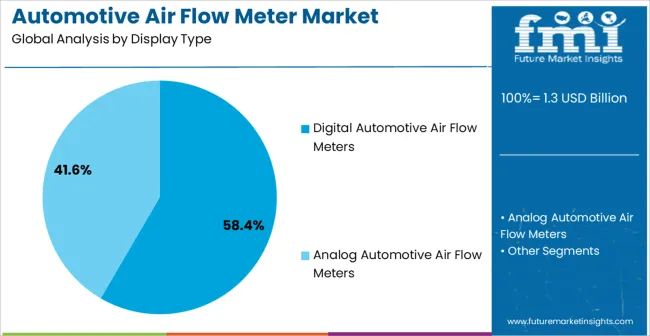
The digital automotive air flow meters segment is projected to capture 58.4% of the market revenue share in 2025, making it the leading display type. Its dominance is being driven by the superior accuracy and real-time monitoring capabilities offered by digital sensors compared to traditional analog counterparts. Digital meters enable enhanced data integration with engine control units, supporting precise air-to-fuel ratio optimization that improves vehicle efficiency and emissions compliance.
Their compatibility with advanced diagnostics and onboard systems ensures faster detection of performance anomalies, which strengthens their role in modern vehicle architectures. Widespread adoption in both passenger and commercial vehicles, coupled with increasing manufacturer preference for long-lasting and low-maintenance solutions, has further reinforced their market position.
Digital solutions also offer adaptability to evolving automotive software ecosystems, allowing for upgrades that extend product lifecycles As automakers prioritize fuel economy and sustainability while addressing stringent emission standards, digital automotive air flow meters are expected to remain the dominant choice, delivering reliability, efficiency, and integration flexibility across diverse vehicle categories.
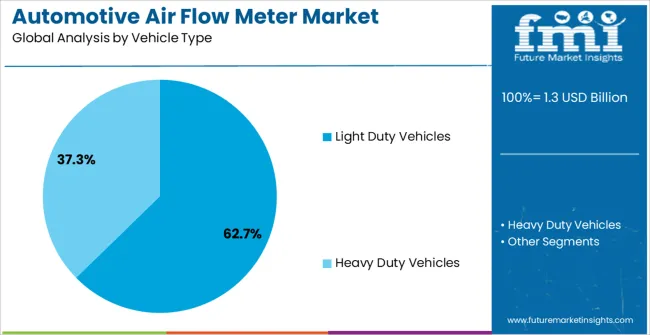
The light duty vehicles segment is expected to account for 62.7% of the market revenue share in 2025, positioning it as the leading vehicle type. Growth in this segment is being supported by the rising global demand for passenger cars and small commercial vehicles that rely heavily on accurate air flow measurement for enhanced fuel efficiency and reduced emissions. Light duty vehicles benefit from advanced digital air flow meter technologies that ensure precise monitoring and contribute to overall engine optimization.
Increasing consumer preference for vehicles with improved mileage, lower emissions, and higher reliability is further driving adoption. The rapid pace of urbanization and expansion of middle-class populations, especially in emerging economies, has spurred rising sales of compact cars and SUVs, boosting demand for efficient engine management systems.
Manufacturers are focusing on integrating lightweight and durable components, including air flow meters, to meet performance and sustainability goals As stricter emission norms and customer expectations for fuel economy continue to evolve, light duty vehicles are expected to dominate market share, driving sustained demand for high-performance air flow measurement solutions.
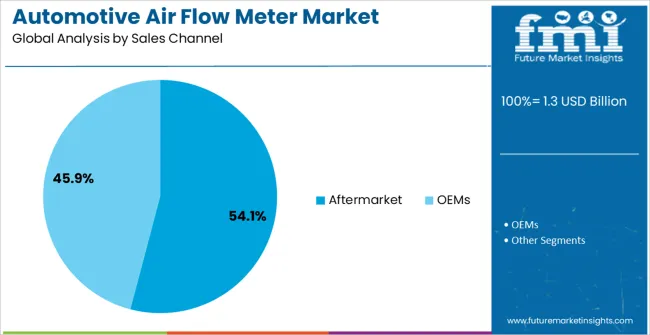
The aftermarket segment is anticipated to hold 54.1% of the market revenue share in 2025, making it the largest sales channel. Growth in this segment is driven by the high replacement rate of air flow meters due to wear and tear, contamination, and performance degradation over time. Vehicle owners increasingly turn to aftermarket suppliers for cost-effective and readily available replacement parts that ensure continued engine performance and regulatory compliance.
Rising demand for customized and performance-enhancing automotive components has further bolstered aftermarket sales. Small and medium-sized workshops play a critical role in driving accessibility, particularly in emerging economies where affordability and availability are key purchase factors. The increasing average age of vehicles in circulation globally has also contributed to the segment’s growth, as older vehicles often require component replacements to maintain operational efficiency.
With growing online sales platforms, distribution networks, and the popularity of do-it-yourself maintenance practices, the aftermarket has strengthened its reach As vehicle lifespans extend and demand for affordable replacements continues, the aftermarket is expected to remain the leading sales channel for automotive air flow meters.
Used primarily for measuring the amount of air flowing into the internal combustion engine, to identify and use the appropriate amount of fuel to be used, the demand for automotive air flow meters is expected to increase worldwide, with increasing diesel and gasoline automotive manufacturing activity.
Increasing dependence of automotive systems on electronics to maintain engine efficiency along with meeting regulations on particulate emissions arising from exhaust systems are some factors that are key in driving the growth rate of the automotive air flow meter market for the foreseeable future.
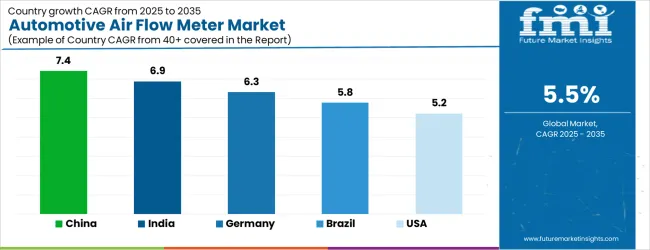
| Country | CAGR |
|---|---|
| China | 7.4% |
| India | 6.9% |
| Germany | 6.3% |
| Brazil | 5.8% |
| USA | 5.2% |
| UK | 4.7% |
| Japan | 4.1% |
The Automotive Air Flow Meter Market is expected to register a CAGR of 5.5% during the forecast period, exhibiting varied country level momentum. China leads with the highest CAGR of 7.4%, followed by India at 6.9%. Developed markets such as Germany, France, and the UK continue to expand steadily, while the USA is likely to grow at consistent rates. Japan posts the lowest CAGR at 4.1%, yet still underscores a broadly positive trajectory for the global Automotive Air Flow Meter Market. In 2024, Germany held a dominant revenue in the Western Europe market and is expected to grow with a CAGR of 6.3%. The USA Automotive Air Flow Meter Market is estimated to be valued at USD 495.1 million in 2025 and is anticipated to reach a valuation of USD 495.1 million by 2035. Sales are projected to rise at a CAGR of 0.0% over the forecast period between 2025 and 2035. While Japan and South Korea markets are estimated to be valued at USD 61.8 million and USD 40.8 million respectively in 2025.
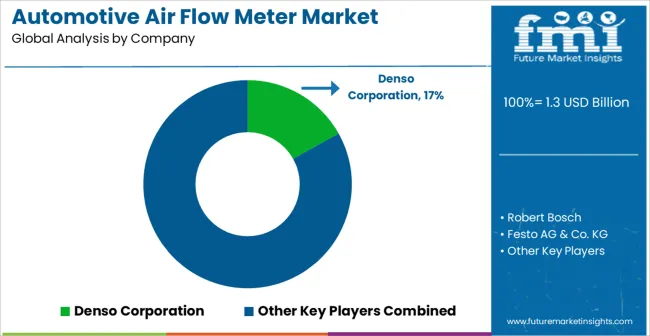
| Item | Value |
|---|---|
| Quantitative Units | USD 1.3 Billion |
| Display Type | Digital Automotive Air Flow Meters and Analog Automotive Air Flow Meters |
| Vehicle Type | Light Duty Vehicles and Heavy Duty Vehicles |
| Sales Channel | Aftermarket and OEMs |
| Regions Covered | North America, Europe, Asia-Pacific, Latin America, Middle East & Africa |
| Country Covered | United States, Canada, Germany, France, United Kingdom, China, Japan, India, Brazil, South Africa |
| Key Companies Profiled | Denso Corporation, Robert Bosch, Festo AG & Co. KG, Hitachi, Delphi Automotive, ACDelco, Mitsubishi Motors, Nissan Motor, and FLIR Systems |
The global automotive air flow meter market is estimated to be valued at USD 1.3 billion in 2025.
The market size for the automotive air flow meter market is projected to reach USD 2.3 billion by 2035.
The automotive air flow meter market is expected to grow at a 5.5% CAGR between 2025 and 2035.
The key product types in automotive air flow meter market are digital automotive air flow meters and analog automotive air flow meters.
In terms of vehicle type, light duty vehicles segment to command 62.7% share in the automotive air flow meter market in 2025.






Our Research Products

The "Full Research Suite" delivers actionable market intel, deep dives on markets or technologies, so clients act faster, cut risk, and unlock growth.

The Leaderboard benchmarks and ranks top vendors, classifying them as Established Leaders, Leading Challengers, or Disruptors & Challengers.

Locates where complements amplify value and substitutes erode it, forecasting net impact by horizon

We deliver granular, decision-grade intel: market sizing, 5-year forecasts, pricing, adoption, usage, revenue, and operational KPIs—plus competitor tracking, regulation, and value chains—across 60 countries broadly.

Spot the shifts before they hit your P&L. We track inflection points, adoption curves, pricing moves, and ecosystem plays to show where demand is heading, why it is changing, and what to do next across high-growth markets and disruptive tech

Real-time reads of user behavior. We track shifting priorities, perceptions of today’s and next-gen services, and provider experience, then pace how fast tech moves from trial to adoption, blending buyer, consumer, and channel inputs with social signals (#WhySwitch, #UX).

Partner with our analyst team to build a custom report designed around your business priorities. From analysing market trends to assessing competitors or crafting bespoke datasets, we tailor insights to your needs.
Supplier Intelligence
Discovery & Profiling
Capacity & Footprint
Performance & Risk
Compliance & Governance
Commercial Readiness
Who Supplies Whom
Scorecards & Shortlists
Playbooks & Docs
Category Intelligence
Definition & Scope
Demand & Use Cases
Cost Drivers
Market Structure
Supply Chain Map
Trade & Policy
Operating Norms
Deliverables
Buyer Intelligence
Account Basics
Spend & Scope
Procurement Model
Vendor Requirements
Terms & Policies
Entry Strategy
Pain Points & Triggers
Outputs
Pricing Analysis
Benchmarks
Trends
Should-Cost
Indexation
Landed Cost
Commercial Terms
Deliverables
Brand Analysis
Positioning & Value Prop
Share & Presence
Customer Evidence
Go-to-Market
Digital & Reputation
Compliance & Trust
KPIs & Gaps
Outputs
Full Research Suite comprises of:
Market outlook & trends analysis
Interviews & case studies
Strategic recommendations
Vendor profiles & capabilities analysis
5-year forecasts
8 regions and 60+ country-level data splits
Market segment data splits
12 months of continuous data updates
DELIVERED AS:
PDF EXCEL ONLINE
Automotive Air Flow Sensors Market Size and Share Forecast Outlook 2025 to 2035
Airflow Balancer Market Size and Share Forecast Outlook 2025 to 2035
Air Flow Sensors Market Size and Share Forecast Outlook 2025 to 2035
Air Flow Monitoring System Market
Flow Meter Devices Market Size, Share, and Forecast 2025 to 2035
Flow Meters Market Growth - Trends & Forecast 2025 to 2035
Flow Cytometer Market
Automotive Airbags Market Size and Share Forecast Outlook 2025 to 2035
Automotive Airbag Controller Unit Market Size and Share Forecast Outlook 2025 to 2035
Automotive Air Filters Market Size and Share Forecast Outlook 2025 to 2035
Automotive Air Filter Market Growth - Trends & Forecast 2025 to 2035
Automotive Air Compressor Market Growth - Trends & Forecast 2025 to 2035
Automotive Airbag Market Growth - Trends & Forecast 2025 to 2035
Automotive Air Intake Manifold Market
Automotive Air Vent Assembly Market
Automotive Repair & Maintenance Services Market Growth - Trends & Forecast 2025 to 2035
Melt Flow Meter Market Size and Share Forecast Outlook 2025 to 2035
Air Entrainment Meters for Mortar Market Size and Share Forecast Outlook 2025 to 2035
Automotive Idle Air Control Valve Market
Automotive Cabin Air Quality Sensors Market Size and Share Forecast Outlook 2025 to 2035

Thank you!
You will receive an email from our Business Development Manager. Please be sure to check your SPAM/JUNK folder too.
Chat With
MaRIA